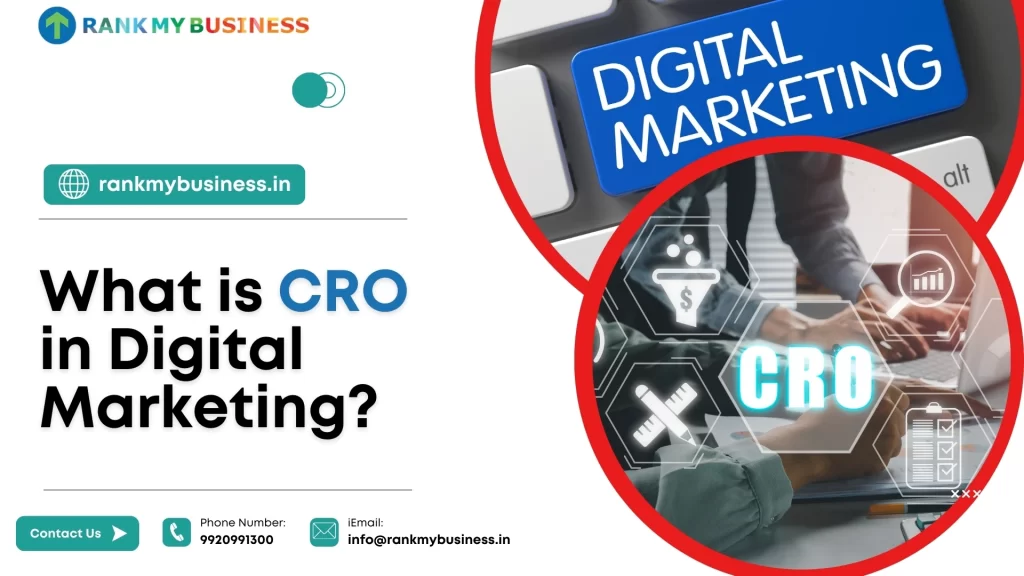What is CRO in Digital Marketing?

In the fast-paced world of digital marketing, success isn’t just about driving traffic to your website—it’s about converting that traffic into tangible results. Whether you’re selling products, offering services, or gathering leads, optimizing the conversion process can make all the difference. This is where Conversion Rate Optimization (CRO) comes in. In this article, we’ll explore what CRO is, why it’s crucial for digital marketing, and how you can use it to boost your online success. What is CRO? At its core, Conversion Rate Optimization (CRO) is the practice of improving your website or landing pages to increase the percentage of visitors who take a desired action. This could be making a purchase, signing up for a newsletter, filling out a form, or any other goal you’ve set for your site. The conversion rate is calculated by dividing the number of visitors who complete the desired action by the total number of visitors. CRO involves tweaking your site to make it easier for users to complete these actions, ultimately increasing your site’s effectiveness and performance. To achieve this, many businesses partner with a CRO Focused Digital Marketing Agency. These agencies specialize in using data-driven strategies, A/B testing, and UX/UI optimizations to boost conversion rates and improve website performance. By working with such an agency, you can ensure that your CRO efforts are aligned with the latest best practices and yield the best possible results. Primary Goal of CRO The primary goal of CRO is simple: to turn more of your website traffic into conversions. But achieving this isn’t as easy as just making a few tweaks. It requires an in-depth understanding of your users, their behaviours, and your site’s performance. Why CRO is Essential for Digital Marketing In today’s competitive digital landscape, simply attracting visitors to your website isn’t enough. If you want to see a real return on your digital marketing efforts, you need to convert that traffic into measurable outcomes—whether it’s sales, sign-ups, or other business goals. This is where Conversion Rate Optimization (CRO) plays a vital role. Here’s why CRO is not just important but essential for the success of your digital marketing strategy: Maximizing Returns on Investment (ROI) When you’re investing in digital marketing campaigns—whether through paid ads, SEO, or content marketing—you want to see a positive return. CRO helps ensure you’re getting the most out of your efforts by maximizing the number of conversions for each visitor to your site. Without CRO, you might be driving a lot of traffic to your site, but if visitors aren’t converting, you’re wasting resources. Optimizing your conversion rate increases the efficiency of your marketing budget and ultimately boosts ROI. Improving Customer Experience CRO isn’t just about increasing conversions; it’s also about creating a better experience for your users. By identifying and addressing obstacles in the user journey, you make it easier for visitors to find what they’re looking for, leading to a smoother, more enjoyable experience. When users have a positive experience, they’re more likely to complete the desired action and return to your site in the future. Key Components of CRO Conversion Rate Optimization (CRO) is a comprehensive process that involves various strategies and tools to improve a website’s ability to convert visitors into customers or leads. To effectively implement CRO, it’s important to understand its core components. These components work together to help you identify obstacles, optimize user experiences, and ultimately boost your conversion rates. Here are the key components of CRO: Data Analysis and Insights The first step in any CRO strategy is understanding your data. This involves using analytics tools to track user behavior, identify drop-off points, and uncover areas where your site could be improved. Data-driven insights allow you to make informed decisions about what changes to implement. User Behavior and Website Design Understanding how users interact with your site is crucial for CRO. This involves studying things like where visitors click, how long they stay on pages, and where they drop off. Analyzing these behaviours allows you to identify design elements that may be hindering conversions and make necessary adjustments to improve usability. A/B Testing and Experimentation One of the most effective methods for improving your conversion rate is A/B testing. This involves creating two versions of a page (Version A and Version B) and testing them with real users to see which performs better. Whether it’s changing the color of your call-to-action (CTA) buttons or testing different headlines, A/B testing allows you to make data-backed decisions about your website’s design and content. How Does CRO Impact Website Performance? Conversion Rate Optimization (CRO) has a direct and powerful impact on the overall performance of a website. By optimizing the user journey and making improvements based on data-driven insights, CRO helps to transform a site from just a traffic magnet into a high-converting asset. Here’s how CRO impacts various aspects of website performance: CRO Enhances Website Usability CRO focuses heavily on enhancing website usability. Small changes, like simplifying navigation or optimizing the mobile experience, can significantly impact a user’s journey. The easier it is for visitors to navigate your site and complete actions, the more likely they are to convert. Reducing Bounce Rates and Increasing Engagement A well-executed CRO strategy reduces bounce rates by improving site design and user flow. By focusing on clear CTAs, faster load times, and easy-to-read content, you encourage users to stay longer on your site, increasing the likelihood of conversion. The more engaged your users are, the more likely they are to take the actions you desire. Key CRO Strategies for Digital Marketers When it comes to Conversion Rate Optimization (CRO), having a solid strategy is key to improving the effectiveness of your digital marketing efforts. By implementing targeted strategies, digital marketers can improve the user experience, encourage more conversions, and ultimately maximize the return on investment. Here are some of the most effective CRO strategies: Simplifying Navigation Visitors should be able to easily find what they’re looking for. Complex, cluttered menus can cause frustration, leading users to leave your site. By simplifying navigation and making















